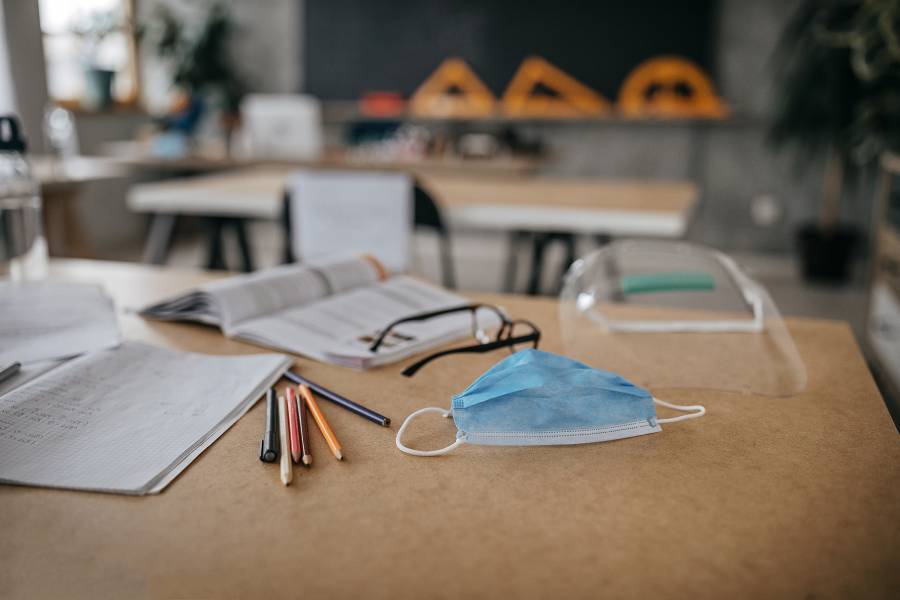To put it lightly, going back to school is looking complicated for K-12 students in the U.S. As they prepare to enter their third consecutive school year impacted by the COVID-19 pandemic, with some schools in the South starting classes this week, the perpetual clashes over masking and vaccines are now compounded by new concerns over variants and transmission. Some districts are considering extending hybrid and online models, and questions remain over how to overcome all of the losses—academic, social, and emotional—the pandemic has wrought.
Last week, a group of experts in educational research practice and policy at Johns Hopkins University gathered to discuss the outlook for the upcoming school year and beyond. Below are some highlights of their talk; the full version is available online.
Risks versus rewards of in-person learning
The recent surge of the delta variant has changed the conversation for many U.S. school districts, some of which are reconsidering plans to return to all in-person learning.
"A lot of people had let their guard down," believing a return to normal was within reach, said Annette Anderson, deputy director of JHU's Center for Safe and Healthy Schools. "But we are not back to that."
The Hopkins researchers said most evidence points toward the high value of in-person learning when schools are behaving responsibly and community spread of the virus is not extreme. They advised parents to take a close look at their schools' COVID-19 preparations and response plans to make sure they're comfortable.
"If they are taking every reasonable precaution, the strong advice of research is to put your child in school," said David Steiner, executive director of the Institute for Education Policy, who previously served as education commissioner for New York.
"On strong average it is psychologically damaging, it is emotionally damaging, it is not a good thing for children to be isolated," Steiner added, noting that the consequences of isolation could last a lifetime. "These are huge value propositions."
While the risks for serious health problems for kids are not zero—particularly because children under 12 are not eligible yet for the vaccines—they're small, Steiner said. "Of course, when it comes to our own children, we want to exaggerate protection," he acknowledged. "That's natural and inevitable and right, and it's what parents should do—but not out of all proportion."
The most vulnerable students
Robert Balfanz, director of the Everyone Graduates Center, said students in critical "transition years" may experience the most significant long-term impacts from COVID-19: kindergartners moving into first grade, students starting middle school, and those starting high school. Many schools, he noted, are also grappling with "double transitions" this fall, like ninth-graders entering high school alongside 10th-graders who missed an in-person freshman experience.
It's critical to ensure students don't miss key moments of academic development, Balfanz said—learning to read, advancing from arithmetic to mathematics, and completing foundational courses for future career paths, such as "the student who wants to take calculus or chemistry and become an engineer, but missed algebra last year because it was done virtually and it wasn't it wasn't a successful experience."
For students who fall behind, Steiner said research has demonstrated the consistent failure of remediation strategies, which can stigmatize children and pull them out of core instruction. Instead, a strategy called "acceleration" is showing more promise in erasing COVID-19 learning losses, he said, keeping students at their grade level and focusing on the most critical skills.
Steiner noted that a number of parents, fed up with witnessing subpar learning experiences, have turned to home-schooling, which he said is "the fastest-growing educational sector in K-12 in the United States." In some school districts, he said, this could lead to dips in funding tied to the number of students enrolled.
The need for uniform guidance
Many parents are frustrated by the ambiguous, sometimes contradictory messaging that informs their education decisions, Anderson said. "There is continually this question of where do parents go for solid information that they can trust."
Steiner noted that the charged politicization over issues like masks has increased confusion. "We do not just have medical experts talking about masks, we have politicians who know absolutely nothing about the topic politicizing mask-wearing and schools," he said. "That is not the behavior of rational, educated society and it's pernicious."
Several Johns Hopkins researchers, including Anderson, penned an op-ed last winter calling for a blue ribbon commission of diverse stakeholders to examine best practices for reopening schools and deliver data-based recommendations. This need persists today, Anderson said last week. "There should be some level of federal guidance overseeing this whole process—maybe not as a regulatory body but as an advisory committee," she said. "It's critically important right now that parents get one voice … so [they] can be comfortable about the direction that our country is going in writ large."








